Fact Sheet 2013–3015
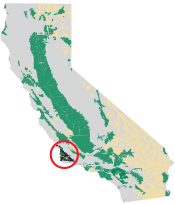
The South Coast Range–Coastal Study Unit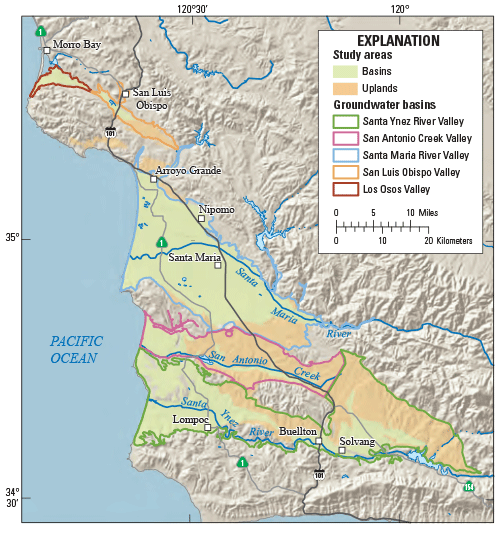
The South Coast Range–Coastal (SCRC) study unit is located in California’s Southern Coast Ranges hydrogeologic province and includes parts of Santa Barbara and San Luis Obispo Counties (Mathany and others, 2010). The SCRC study unit includes five groundwater basins—Los Osos Valley, San Luis Obispo Valley, Santa Maria River Valley, San Antonio Creek Valley, and Santa Ynez River Valley (California Department of Water Resources, 2003)—as well as upland areas of Plio-Pleistocene non-marine and Pliocene marine sediments that are adjacent to the groundwater basins. The 766-square-mile study unit was separated into the two study areas (Basins and Uplands) on the basis of alluvial and terrace deposits found in the five groundwater basins. The climate in the SCRC study unit is influenced in large part by the Pacific Ocean as well as by the topography of the surrounding areas. The coastal lowlands and valleys near the Pacific Ocean have a coastal climate, with warm, dry summers and cool, wet winters. The slopes of the coastal valleys and within the upland areas have a Mediterranean climate with hot, dry summers and cool, wet winters. Average annual rainfall ranges from 13 inches in the coastal lowlands to 20 inches in the uplands. The Santa Maria and Santa Ynez Rivers and San Antonio Creek are the major streams in the SCRC study unit. The primary aquifer system consists of alluvial sediments (mixture of gravel, clay, silt, and sand), the Paso Robles Formation (unconsolidated to poorly consolidated coarse sand and gravel), and the Careaga Sand (unconsolidated fine- to medium-grained marine sand). The primary aquifer system is defined as that part of the aquifer corresponding to the perforated depth intervals of wells listed in the California Department of Public Health (CDPH) database. CDPH wells are typically drilled to depths between 265 and 630 feet below land surface and are perforated or screened at depths below 115–350 feet (Burton and others, 2013). Water quality in the primary aquifer system may differ from that in the shallower and deeper parts of the aquifers. Land use in the study unit is approximately 61 percent (%) natural, 29% agricultural, and 10% urban. The primary agricultural uses are for vegetables and flowers, vineyards, and pasture and hay. The largest urban areas are the cities of Lompoc, Santa Maria, Arroyo Grande, and San Luis Obispo (Burton and others, 2013). The primary source of recharge to the groundwater flow system is from percolation of precipitation, irrigation waters, seepage from streams and rivers, subsurface inflow, and engineered recharge (California Department of Water Resources, 2003). The primary sources of groundwater discharge are water pumped for irrigation and municipal supply. Overview of Water Quality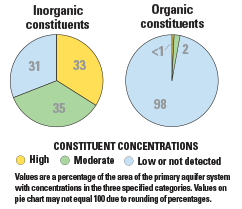
GAMA’s Priority Basin Project evaluates the quality of untreated groundwater. However, for context, groundwater quality was compared to benchmarks established for drinking-water quality. Benchmarks and definitions of high, moderate, and low concentrations are discussed in the inset box on page 3. Many inorganic constituents occur naturally in groundwater. The concentrations of inorganic constituents can be affected by natural processes as well as by human activities. In the SCRC study unit, one or more inorganic constituents with human-health benchmarks were present at high concentrations in 33% of the primary aquifer system and at moderate concentrations in 35%. Organic constituents are found in products used in the home, business, industry, and agriculture. Organic constituents can enter the environment through normal usage, spills, or improper disposal. In the SCRC study unit, one or more organic constituents were present at high concentrations in less than (<) 1% of the primary aquifer system and at moderate concentrations in 2%. RESULTS: Groundwater Quality in the South Coast Range–Coastal Study Unit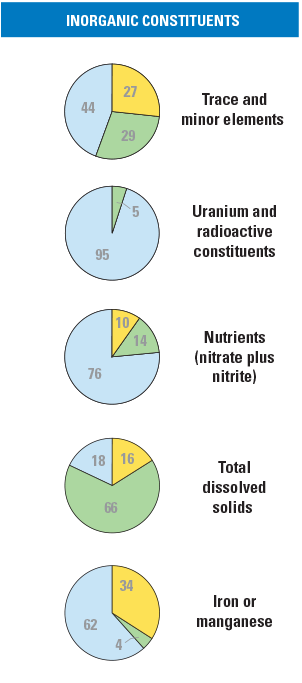
Inorganic Constituents with Human-Health BenchmarksTrace and minor elements are naturally present in the minerals in rocks and soils and in the water that comes into contact with those materials. In the SCRC study unit, trace elements were present at high concentrations in 27% of the primary aquifer system and at moderate concentrations in 29%. Arsenic and molybdenum were present at high concentrations in 7% and 25% of the primary aquifer system, respectively. Barium, copper, and selenium also were detected at high concentrations, but in <1% of the primary aquifer system. Radioactivity is the release of energy or energetic particles during structural changes in the nucleus of an atom. Most of the radioactivity in groundwater comes from decay of naturally occurring isotopes of uranium and thorium in minerals in the aquifer sediments. Radioactive constituents were not present at high concentrations in the primary aquifer system, but were present at moderate concentrations in 5%. Nutrients, such as nitrate and nitrite, are naturally present at low concentrations in groundwater. High and moderate concentrations generally occur as a result of human activities, such as applying fertilizer to crops. Livestock, when in concentrated numbers, and septic systems also produce nitrogenous waste that can leach into groundwater. Nitrate plus nitrite was present at high concentrations in 10% of the primary aquifer system and at moderate concentrations in 14%. Inorganic Constituents with Non-Health Benchmarks(Not included in water-quality overview charts shown on the front page) Some constituents, such as total dissolved solids (TDS), can affect the aesthetic properties of water, such as taste, color, and odor. Other constituents, such as iron and manganese, can create nuisance problems, such as scaling and staining. The State of California has a recommended and an upper limit for TDS in drinking water. TDS is a naturally occurring constituent that results from the weathering and dissolution of minerals in soils and rocks. In the SCRC study unit, TDS was present at high concentrations (above the upper limit) in 16% of the primary aquifer system and at moderate concentrations (between the recommended and upper limit) in 66% of the primary aquifer system. Iron and manganese are naturally occurring elements that may be released from minerals in soils and rocks under very low dissolved oxygen conditions. Iron, manganese, or both were present at high concentrations in 34% of the primary aquifer system and at moderate concentrations in 4%. 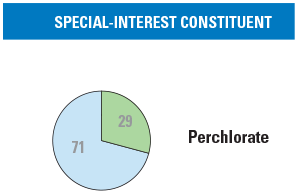
Constituent of Special Interest: Perchlorate(Not included in water-quality overview charts shown on the front page) Perchlorate is an inorganic constituent that has been regulated in California drinking water since 2007. It is an ingredient in rocket fuels, fireworks, and other products, may be present in some fertilizers, and can occur naturally at low concentrations in groundwater. In the SCRC study unit, perchlorate was not present at high concentrations in the primary aquifer system, but was present at moderate concentrations in about 29%. 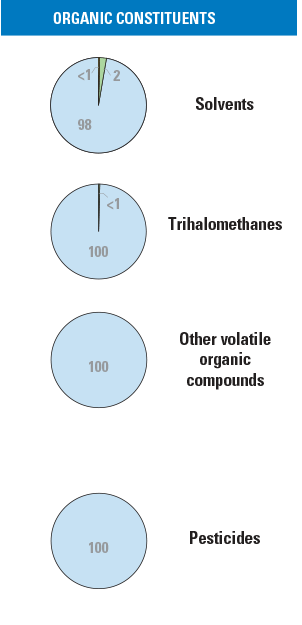
Organic ConstituentsThe Priority Basin Project uses laboratory methods that can detect low concentrations of volatile organic compounds (VOCs) and pesticides, far below human-health benchmarks. The presence of VOCs and pesticides detected at these low concentrations can be used to trace water from the landscape into the aquifer system. Volatile Organic Compounds with Human-Health BenchmarksVOCs are used in many household, commercial, industrial, and agricultural products and are characterized by their tendency to volatilize (evaporate) into the air. Solvents are used for a number of purposes, including manufacturing and cleaning. In the SCRC study unit, solvents were present at high concentrations in <1% of the primary aquifer system. The solvent detected at high concentrations was perchloroethene (PCE). Solvents were present at moderate concentrations in about 2% of the primary aquifer system and were low or not detected in 98%. Trihalomethanes may form during water purification and can enter groundwater by the infiltration of landscape irrigation water. Trihalomethanes were present at moderate concentrations in <1% of the primary aquifer system and at low concentrations or not detected in about 100%. Other VOCs include organic synthesis reagents, refrigerants, and gasoline hydrocarbons. Other VOCs were not detected or were present at low concentrations in 100% of the primary aquifer system. Pesticides with Human-Health BenchmarksPesticides are applied to crops, gardens, lawns, around buildings, and along roads to help control unwanted vegetation, insects, fungi, and other pests. In the SCRC study unit, pesticides were not detected or were present at low concentrations in 100% of the primary aquifer system. BENCHMARKS FOR EVALUATING GROUNDWATER QUALITY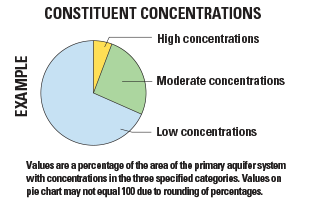
GAMA’s Priority Basin Project uses benchmarks established for drinking water to provide context for evaluating the quality of untreated groundwater. After withdrawal, groundwater may be disinfected, filtered, mixed, and exposed to the atmosphere before being delivered to consumers. Federal and California regulatory benchmarks for protecting human health (Maximum Contaminant Level, MCL) were used when available. Non-regulatory benchmarks for protecting aesthetic properties such as taste and odor (Secondary Maximum Contaminant Level, SMCL) and non-regulatory benchmarks for protecting human health (Notification Level, NL, and Lifetime Health Advisory, HAL) were used when Federal or California regulatory benchmarks were not available. High, moderate, and low concentrations are defined relative to benchmarksConcentrations are considered high if they are greater than a benchmark. For inorganic constituents, concentrations are moderate if they are greater than one-half of a benchmark. For organic and special-interest constituents, concentrations are moderate if they are greater than one-tenth of a benchmark; this lower threshold was used because organic constituents generally are less prevalent and have smaller concentrations relative to benchmarks than inorganic constituents. Low includes nondetections and values less than moderate concentrations. Methods for evaluating water quality are discussed in Burton and others (2013). Factors that Affect Groundwater QualityIn the SCRC study unit, molybdenum and nitrate are two constituents that were detected at high concentrations in the primary aquifer system (Burton and others, 2013). The non-regulatory U.S. Environmental Protection Agency (USEPA) HAL for molybdenum is 40 micrograms per liter (μg/L), and the regulatory USEPA MCL for nitrate is 10 milligrams per liter (mg/L) as nitrogen. Molybdenum is a trace element that occurs naturally in aquifer sediments. Molybdenum can be mobilized under geochemical conditions indicated by low dissolved oxygen (DO) or high pH (Goldberg, 2009). High and moderate concentrations of molybdenum in the SCRC study unit were prevalent when DO was <2 mg/L. Molybdenum concentrations also tended to increase as pH increased when DO was >2 mg/L, likely the result of pH-dependent desorption from aquifer sediments (Burton and others, 2013). Nitrate is a naturally occurring constituent, although concentrations greater than 2 mg/L generally indicate the presence of nitrate from human activities such as application of fertilizer, the use of septic systems, and domesticated animal waste. The correlation between nitrate concentrations and groundwater age suggests elevated nitrate concentrations in SCRC study unit groundwater are the result of human activities (Burton and others, 2013). High concentrations of nitrate were detected in wells with groundwater of modern age (groundwater recharged since 1952). Low concentrations of nitrate were detected in wells with groundwater of pre-modern age (groundwater recharged before 1952). Nitrate concentrations also can be affected by geochemical conditions indicated by DO concentration. In contrast to molybdenum, nitrate concentrations generally were low in groundwater having DO <2 mg/L, likely because nitrate can be degraded in low DO conditions (Kendall, 1998). 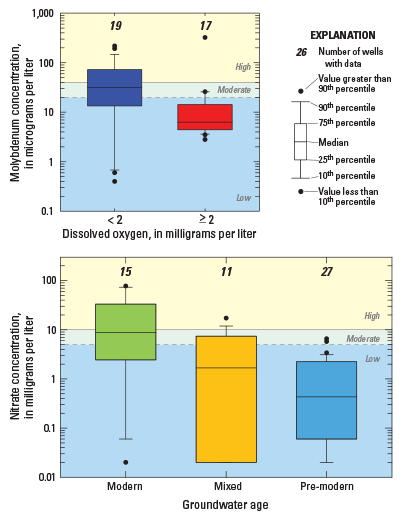
Priority Basin AssessmentsGAMA’s Priority Basin Project (PBP) assesses water quality in that part of the aquifer system used for drinking water, primarily public supply. Water quality in the primary aquifer system, assessed by the PBP, may differ from water quality in the shallower and deeper parts of the aquifers. GAMA’s Domestic Well Project assesses water quality in the shallower parts of the aquifer system. Ongoing PBP assessments are being conducted in more than 120 basins throughout California. The PBP assessments are based on a comparison of constituent concentrations in untreated groundwater with benchmarks established for the protection of human health and for aesthetic concerns for drinking water. The PBP does not evaluate the quality of drinking water delivered to consumers. The PBP uses two scientific approaches for assessing groundwater quality. The first approach uses a network of wells to statistically assess the status of groundwater quality. The second approach combines water-quality, hydrologic, geographic, and other data to help assess the factors that affect water quality. In the SCRC study unit, data were collected by the PBP in 2008 and compiled from the CDPH database for 2005–2008. The PBP includes chemical analyses not generally required as part of regulatory compliance monitoring, including measurements at concentrations much lower than human-health benchmarks, and measurement of constituents that can be used to trace the sources and movement of groundwater. SELECTED REFERENCESBurton, C.A., Land, M.T., and Belitz, Kenneth, 2013, Status and understanding of groundwater quality in the South Coast Range–Coastal study unit, 2008—California GAMA Priority Basin Project: U.S. Geological Survey Scientific Investigations Report 2013-5053, 85 p. Available at https://pubs.usgs.gov/sir/2013/5053. California Department of Water Resources, 2003, California’s groundwater: California Department of Water Resources Bulletin 118, 246 p. Available at http://www.water.ca.gov/groundwater/bulletin118/bulletin118update2003.cfm. Goldberg, Sabine, 2009, Influence of soil solution salinity on molybdenum adsorption by soils: Soil Science, v. 174, p. 9–13. Kendall, C., 1998, Tracing nitrogen sources and cycling in catchments, in Kendall, C., and McDonnell, J.J., eds., Isotope tracers in catchment hydrology: Amsterdam, Elsevier Science, chapter 16, p. 519–576. Mathany, T.M., Burton, C.A., Land, Michael, and Belitz, Kenneth, 2010, Groundwater-quality data in the South Coast Range–Coastal study unit, 2008—Results from the California GAMA Program: U.S. Geological Survey Data Series 504, 106 p. Available at https://pubs.usgs.gov/ds/504/. |
First posted September 26, 2013
For additional information contact: Technical reports and hydrologic data collected for the GAMA Program may be obtained from GAMA Project Chief GAMA Program Unit Chief Part or all of this report is presented in Portable Document Format (PDF); the latest version of Adobe Reader or similar software is required to view it. Download the latest version of Adobe Reader, free of charge. |
Burton, C.A., and Belitz, Kenneth, 2013, Groundwater quality in the South Coast Range Coastal groundwater basins, California: U.S. Geological Survey Fact Sheet 2013–3015, 4 p.